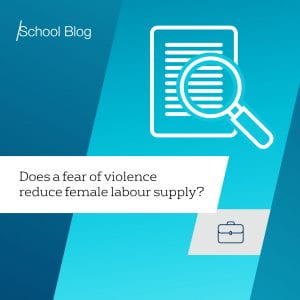 Dr Zahra Siddique, Senior Lecturer in Economics highlights important findings further to her latest research on violence against women and labour supply in developing countries.
Dr Zahra Siddique, Senior Lecturer in Economics highlights important findings further to her latest research on violence against women and labour supply in developing countries.
Does a fear of violence reduce female labour supply?
Incidents of sexual assaults and rapes within developing countries sometimes receive extensive coverage in the local media. A few notable examples include: the December 2012 Delhi gang rape and murder case and, more recently, the September 2020 gang rape in the south eastern Noakhali district of Bangladesh. Such high-profile media reporting could (inadvertently) make the extreme consequences of being a violence victim salient for working age women and deter them from going out of their homes to work. In recently published research I examine the importance of this behavioural relationship using data from urban India (Siddique 2020).
Recent empirical research indicates that fear and safety concerns of women outside the home in India are likely to play an important role in their economic activity. Muralidharan and Prakash (2017) find that providing girls in the Indian state of Bihar with a bicycle improved secondary school enrolment by making it safer and quicker for girls to travel to school. Borker (2018) finds that women are willing to choose a lower quality college at the University of Delhi for a travel route that they perceive to be safer. Chakraborty et al. (2018) find that in urban neighbourhoods where the self-reported level of sexual harassment against women is high, women are far less likely to seek outside employment.
In my research I use data on the Indian labour market between 2009 and 2012, combining this with a geographically referenced data source on media reports of physical and sexual assaults that occur in Indian districts over time. This enabled me to investigate the effect of media reported violence in the local area (or Indian district) in the past quarter on a resident woman’s decision to work outside her home today. Using statistical methods that allowed me to rule out several sources of spurious correlation, I found that a one standard-deviation increase in sexual assault reports per 1000 people within the local area of a woman led to a reduction in the probability that she worked outside her home by 5.5% of the sample average of female labour supply. In contrast, physical assault reports had no effect on whether women worked outside the home. Neither did sexual assault reports on whether men worked outside the home. I found that the negative effect of media reported violence on female labour supply was strongest among young women (age 18 to 25). However, I also found that this effect was short-lived, with female labour supply increasing to catch-up following an initial decline.
Policy Implications
The results of this research highlight the importance of addressing safety concerns of women in India, particularly young women. Longer term interventions would involve strengthening of a policing and legal framework that protects women from sexual assaults. Shorter term interventions could involve provision of special transport facilities for women: Aguilar et al (forthcoming) examine a program that reserves subway cars for women in Mexico City and find that this reduces sexual harassment towards women while Kondylis et al (2018) find that riding in women reserved safe spaces reduces harassment against women in Rio de Janeiro. However, both studies also find negative effects; in Mexico City there is an increase in non-sexual aggression incidents among men while in Rio de Janeiro there is stigmatization of women who ride female only cars. Hence policy prescriptions to address women’s safety concerns need some care and thought to be implemented most effectively.
References:
• Aguilar, A., Gutierrez, E. and Villagran, P. S. (forthcoming), ‘Benefits and unintended consequences ofgender segregation in public transportation: Evidence from mexico city’s subway system’, forthcoming in Economic Development and Cultural Change.
• Borker, G (2018), ‘Safety first: Perceived risk of street harassment and educational choices of women’, Job Market Paper. Available here.
• Chakraborty, Tanika, Anirban Mukherjee, Swapnika Reddy Rachapalli and Sarani Saha (2018), “Stigma of sexual violence and women’s decision to work”, World Development, 103: 226-238.
• Kondylis, F., Legovini, A., Vyborny, K., Zwager, A. and Andrade, L. (2018), Demand for safe spaces:Avoiding harassment and stigma. Unpublished Manuscript.
• Muralidharan, Karthik and Nishith Prakash (2017), “Cycling to school: Increasing secondary school enrolment for girls in India”, American Economic Journal: Applied Economics, 9(3): 321-350.
• Siddique, Z (2020), ‘Media reported violence and female labor supply’, accepted for publication in Economic Development and Cultural Change.

